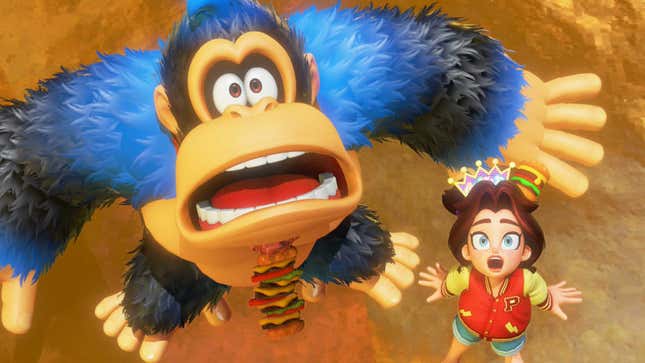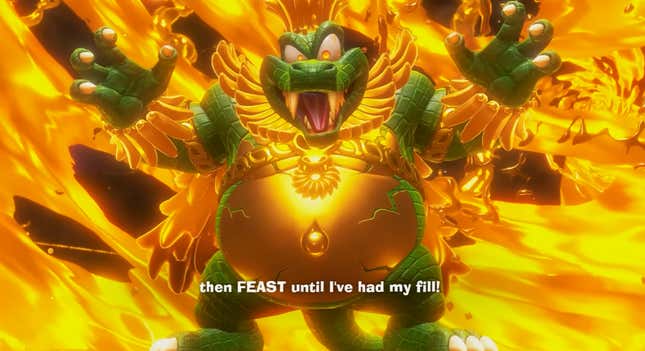
Endings can do a lot to color how we remember something. The right song just as the credits roll can help an unwieldy story click into place (Star Ocean: Second Story). Dozens of hours spent pleasantly trekking through a satisfying adventure can be soured in the final moments thanks to a terrible boss fight (Final Fantasy VII Rebirth). Donkey Kong Bananza’s ending turns it from a very good game into a great one, and it’s arguably the best ending to a Nintendo game in years.
Do you want to hear more? Have you finished Donkey Kong Bananza for yourself yet? I strongly suggest you go do that before continuing on. This is your last change to turn back unless you don’t think you’ll ever play the game or really, really don’t care about spoilers.

The goal of Donkey Kong Bananza is to get to the planet’s core. That’s where the Banandium Root resides. Believing it has the power to grant wishes, Donkey Kong and Pauline set out to claim it for themselves. The journey takes you through 16 different layers of the world before you finally get there, collecting Banandium Gems, unlocking new skills, and defeating members of the evil mining company VoidCo along the way. It’s long, especially if you take your time to hunt down hidden bananas and other secrets on every level.
I wasn’t expecting its story to pay off with any particularly big surprises, but right before you reach the Planet Core, Donkey Kong Bananza reveals the true final boss that’s been waiting in the wings: King K. Rool. The Kremlin leader hasn’t been in a Donkey Kong game since the 2007 spin-off Donkey Kong: Jungle Climber. He’s not in any of the marketing for Bananza and fans have been debating for months whether Nintendo would actually bring him back after all this time.

Nostalgic callbacks are neat, but it’s the boss fight itself that delivers on the long-overdue cameo. In a big arena surrounded by golden Banandium, he whips out his iconic Blunderbuss to fire off Kannonballs just like old times. Being surrounded by all that Banandium lets DK stay transformed the whole time to make use of all of his powers, and the elephant form proves to be particularly useful, letting DK snort up all the rot and fire it back at K. Rool. When the Kremling King tries to suck DK up in his Blunderbuss, you can launch boulders at it to make it explode on him. It’s an excellent showdown that riffs on the final boss fight in Donkey Kong Country 2 while using all of Bananza’s modern, Super Mario Odyssey-inspired tricks.
It would be cool enough if everything stopped there, but in keeping with its tribute to Donkey Kong’s past, Bananza pulls a DKC1-style credits fake-out to lead into phase two of the fight. Except that instead of a harder redux of what just transpired, Bananza goes full Uncharted and turns the final stretch of the game into one long set piece. First DK and Pauline have to ride a massive pillar of bananas to the surface, fighting a flying K. Rool along the way. Fending him off, they finally break through the planet’s surface only to find themselves in New Donk City from Super Mario Odyssey, where we first met grown-up Pauline back during the launch year of the original Switch.
New Donk City would have been a wild reveal for an after-credits stinger. Instead it’s just the prelude to one final platforming section as Banandium rot fills up the entire city and DK races to K. Rool’s fortress in the sky. It’s a bit like the final level in Super Mario 3D World where Bowser becomes a cat and has you chase him up the side of his tower. How many residents of New Donk City were harmed as the streets flooded with molten banana mush? Too many. But the action finally culminates in a second boss fight that’s even more spectacular than the first. Donkey Kong Bananza runs decently most of the time on Switch 2, but there are moments when K. Rool coats the entire arena in Banandium rot that sent my framerate crashing into the single digits in handheld mode.
There’s only one snag in this roller coaster ride, and that’s the checkpointing. Instead of letting you load directly into fights, you have to do the brief platforming sections right before them again each time you die. Turn off the game and you’ll have to start the New Donk City portion all over again. With the right power-ups the fight isn’t nearly as hard as the DKC2 one that inspires it, but if you’re out of items or didn’t upgrade your elephant transformation enough, you might be in for a rough time. I’ll also say that while the music is properly cinematic and sweeping, it’s nowhere near as iconic as the original boss fight melodies from DKC1 and DKC2.
All that said, the ending of Bananza might still be my favorite ending to a Nintendo game since at least the start of the original Switch era. Super Mario Odyssey also had a big surprise waiting for players after its final fight, too. Like a lot of other pieces of that game, it feels like Bananza’s ending takes some of those ideas an expands them, while playing to the strengths and leaning into the fan service elements unique to Donkey Kong. Unlike Mario, who gets big new games every console generation, DK’s been on the bench for over a decade, and King K. Rool even longer. The end of Bananza offers fans of both a well-deserved payout.
.